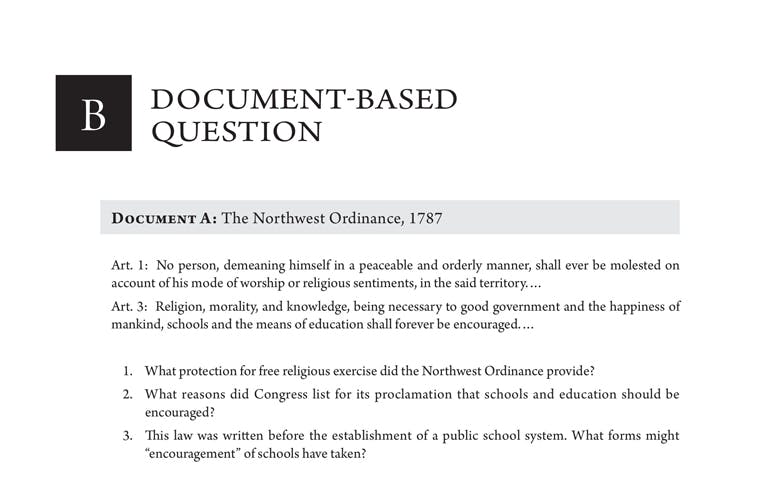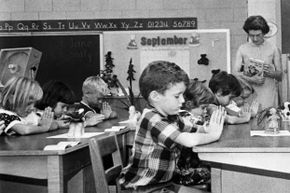Handout B: Religious Liberty and the Supreme Court Document-Based Question
Document-Based Question
Directions: Read the document excerpts and answer the questions.
Document A: The Northwest Ordinance, 1787
Art. 1: No person, demeaning himself in a peaceable and orderly manner, shall ever be molested on account of his mode of worship or religious sentiments, in the said territory.…
Art. 3: Religion, morality, and knowledge, being necessary to good government and the happiness of mankind, schools and the means of education shall forever be encouraged.…
- What protection for free religious exercise did the Northwest Ordinance provide?
- What reasons did Congress list for its proclamation that schools and education should be encouraged?
- This law was written before the establishment of a public school system. What forms might “encouragement” of schools have taken?
Document B: The First Amendment, 1791
Congress shall make no law respecting an establishment of religion, or prohibiting the free exercise thereof; or abridging the freedom of speech, or of the press; or the right of the people peaceably to assemble, and to petition the government for a redress of grievances.
- Underline the five freedoms protected by the First Amendment.
- To which level of government did these limitations apply in 1791?
- Is freedom of religion the only protection that might apply to the situation in the Key Question? Why or why not?
Document C: The Fourteenth Amendment, 1868
No state shall make or enforce any law which shall abridge the privileges or immunities of citizens of the United States; nor shall any state deprive any person of life, liberty, or property, without due process of law; nor deny to any person within its jurisdiction the equal protection of the laws.
- How has the Supreme Court interpreted this amendment to broaden the application of certain Bill of Rights protections?
Document D: Engel v. Vitale, 1962
When the power, prestige and financial support of government is placed behind a particular religious belief, the indirect coercive pressure upon religious minorities to conform to the prevailing officially approved religion is plain.
- In the Key Question scenario, is Jason’s speech backed by the “power, prestige and financial support of government”? Why or why not?
Document E: First Graders Pray in Classroom, 1966
- The Supreme Court overturned public school-required prayer as unconstitutional in 1962. What are some reasons this scene might have taken place in South Carolina in 1966?
Document F: Tinker v. Des Moines Independent Community School District, 1969
In our system, state-operated schools may not be enclaves of totalitarianism. School officials do not possess absolute authority over their students. Students in school as well as out of school are “persons” under our Constitution. …In our system, students may not be regarded as closed-circuit recipients of only that which the State chooses to communicate. They may not be confined to the expression of those sentiments that are officially approved. …The prohibition of expression of one particular opinion, at least without evidence that it is necessary to avoid material and substantial interference with schoolwork or discipline, is not constitutionally permissible.
- According to this decision, do students a have right to free speech in schools?
- How far does that right go?
Document G: Dissenting Opinion, Wallace v. Jaffree, 1985
[In this case,] the Court strikes down an Alabama statute because the State wished to “characterize prayer as a favored practice.” It would come as much of a shock to those who drafted the Bill of Rights as it will to a large number of thoughtful Americans today to learn that the Constitution, as construed by the [Supreme Court] majority, prohibits the Alabama Legislature from “endorsing” prayer. George Washington himself, at the request of the very Congress which passed the Bill of Rights, proclaimed a day of “public thanksgiving and prayer, to be observed by acknowledging with grateful hearts the many and signal favors of Almighty God.” History must judge whether it was the Father of his Country in 1789, or a majority of the Court today, which has strayed from the meaning of the Establishment Clause.
- In this decision, the Court struck down Alabama’s law allowing teachers to set aside a moment of silence for “meditation or voluntary prayer.” On what basis does this dissenting Justice object to the ruling?
- How persuasive is his reasoning?
Document H: Bethel School District v. Fraser, 1986
[T]he constitutional rights of students in public school are not automatically coextensive with the rights of adults in other settings….
- What does the Court say about the rights of students?
Document I: Board of Education of Westside Community Schools v. Mergens, 1990
[T]here is a crucial difference between government speech endorsing religion, which the Establishment Clause forbids, and private speech endorsing religion, which the Free Speech and Free Exercise Clauses protect. We think that secondary school students are mature enough and are likely to understand that a school does not endorse or support student speech that it merely permits on a nondiscriminatory basis…. The proposition that schools do not endorse everything they fail to censor is not complicated.
- In the Key Question scenario, would Jason’s valedictory address be an example of “government speech endorsing religion,” “private speech endorsing religion,” neither, or both? Explain.
Document J: Lee v. Weisman, 1992
The government involvement with religious activity in this case is pervasive, to the point of creating a state-sponsored and state-directed religious exercise in a public school…. A school official, the principal, decided that an invocation and a benediction should be given; this is a choice attributable to the state, and, from a constitutional perspective, it is as if a state statute decreed that the prayers must occur. The principal chose the religious participant, here a rabbi, and that choice is also attributable to the state.
- Why is the Court concerned with whether a choice would be “attributable to the state”?
- In the Key Question scenario, would the content of Jason’s speech be “attributable to the state”? Why or why not?
Document K: Capitol Square Review and Advisory Bd. v. Pinette, 1995
[P]rivate religious speech…is as fully protected … as secular private expression. Indeed, in Anglo-American history, at least, government suppression of speech has so commonly been directed precisely
at religious speech that a free-speech clause without religion would be Hamlet without the prince.
- In the Key Question scenario, would Jason’s valedictory address be an example of “private religious speech”? Why or why not?
Document L: Adler v. Duval, 11th Cir. 2001
While school officials may make private religious speech their own by endorsing it, schools do not endorse all speech that they do not censor.
- Rephrase the Circuit Court’s statement in your own words.

